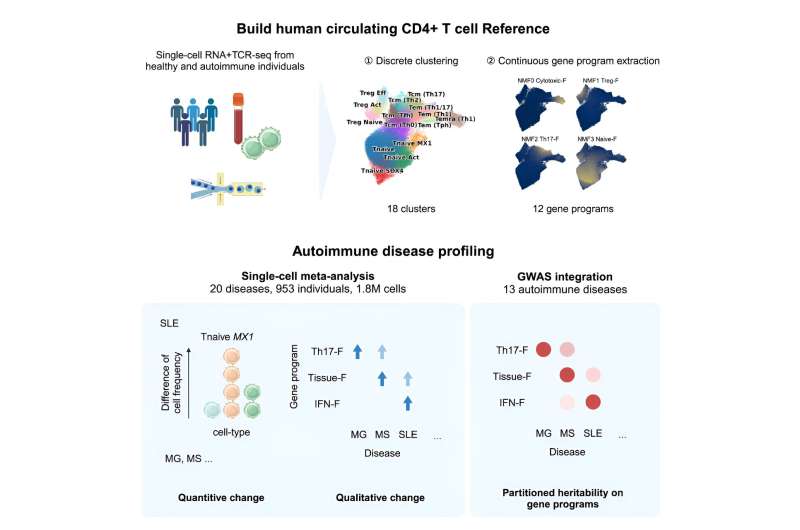This article has been reviewed according to Science X's editorial process and policies. Editors have highlighted the following attributes while ensuring the content's credibility:
fact-checked
peer-reviewed publication
trusted source
proofread
Small changes in specific immune cell populations linked to autoimmune disorders

Much like ripples on the water can betray powerful currents below the surface, small changes in our bodies can sometimes be an indicator of a serious condition. Now, researchers from Japan say that cells in the blood may provide telltale signs of important immune dysfunction.
In a study recently published in Cell Genomics, researchers from Osaka University have revealed that subtle changes in specific immune cell populations may signal the presence of an autoimmune disease.
In autoimmune conditions, which affect up to 5% of the population, the body's immune cells attack the body instead of disease-causing agents. A subset of immune cells known as CD4+ T cells are known to play a key role in the onset and progression of many autoimmune diseases.
"CD4+ T cells can exist in a naive or memory state, can exhibit polarization to a Th1, Th2, Th17, or Tfh phenotype, or can be regulatory T cells," says lead author of the study Yoshiaki Yasumizu. "However, there is still a lot of heterogeneity among the cells in these categories, and the effect that this has on autoimmune disease remains largely unclear."
To address this, the researchers used single-cell RNA sequencing and an analytical approach known as non-negative matrix factorization to analyze the gene expression profiles of CD4+ T cells in healthy individuals and patients with autoimmune diseases. This analysis identified 18 different types of CD4+ T cells and 12 distinct gene programs, which were then used as a reference to analyze almost 2 million CD4+ T cells from nearly 1,000 people with 20 different autoimmune diseases.
"The results were very exciting," explains Shimon Sakaguchi, senior author. "We found that characteristic changes in CD4+ T cells defined by the 18 categories and 12 gene programs were associated with specific autoimmune diseases, suggesting that these conditions have a detectable 'signature.'"
In addition, the researchers detected distinctive changes in CD4+ T cell categories and gene programs that were linked to aging and sex, two factors that are known to influence the risk of developing an autoimmune disorder. Furthermore, genetic factors that promote disease development accumulated in CD4+ T cells exhibiting specific gene programs.
"Our study presents a comprehensive catalog of the CD4+ T cell changes that are seen in 20 different autoimmune diseases, providing an invaluable resource for researchers," says Yasumizu.
In the future, this catalog could potentially be used to detect autoimmune disease in patients by simply taking a blood sample and analyzing the CD4+ T cell features, thus paving the way for precision medicine.
More information: Yoshiaki Yasumizu et al, Single-cell transcriptome landscape of circulating CD4+ T cell populations in autoimmune diseases, Cell Genomics (2024). DOI: 10.1016/j.xgen.2023.100473



















